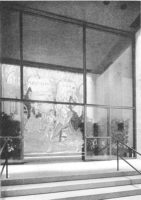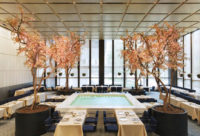An unexpected downside of landmarking an interior is that movable components are not part of the deal. This is sadly true of the elegantly modernist furniture, place settings, and graphic design—even the logo—integral to the identity of the ultra-luxe Four Seasons Restaurant designed by Philip Johnson in the Seagram Building at 52nd and Park Avenue in New York. Yes, the landmark protection for the 29,500-square-foot space for the Grill Room, Pool Room, and lobby includes the swank bronze-railed stairways, walnut-paneled walls, sleek aluminum ceilings, and the ebonized oak or travertine floors. It also applies to the swagged anodized-aluminum beaded curtains and to the gold-dipped brass-rod sculptures by Richard Lippold suspended over the bar and mezzanine of the Grill Room. But the rest of this gesamtkunstwerk will be auctioned off on July 26, 10 days after the fabled 57-year-old culinary and architectural institution closes.
Granted, the price of admission, even for a Pinot Noir, is steep. Yet you always feel you are entering a shrine to Architecture with a capital A the moment you encounter its beautifully proportioned precincts, where the burnished sheen of lush materials forms the gestalt. Now Mies van der Rohe’s Barcelona and Brno chairs—as well as those by Charles Eames and Hans Wegner, bronze tulip tables and pedestal chairs by Eero Saarinen, sofas by Philip Johnson, banquettes by Florence Knoll, and tableware by Garth and Ada Louise Huxtable will soon be dispersed to parts unknown.
A new restaurant management then takes over, brought in by the current Seagram Building owner Aby Rosen of RFR Holding. The reason for the upheaval: Rosen upped the rent to a point that the Four Seasons proprietors Julian Niccolini and Alex von Bidder felt forced to look elsewhere for new premises. Rosen wasn’t willing to pay the price for the furnishings, and it would have been difficult to integrate the ensemble into a new space, so the restaurateurs are selling the lot. “We decided not to duplicate anything from the original,” says von Bidder. “I always say, ‘Don’t step into your father’s shoes, but seek what he was seeking.’ ”
The Four Seasons will take its name, logo, the graphic design, and the theme of changing seasons to 280 Park Avenue at 48th Street. There São Paulo–based architect Isay Weinfeld has about 18 months to complete a scheme for the new 20,000-square-foot establishment in the ground floor of the office tower designed by Emery Roth & Sons in 1961. Weinfeld, selected through a process guided by critic Paul Goldberger, is responsible for the sleek midcentury-modern look of the Fasano Hotel in São Paulo. “He has a soulfulness to his designs that is magical,” says von Bidder.
The Four Seasons Restaurant was born a year after the completion of Ludwig Mies van der Rohe’s masterful Seagram Building (RECORD, July 1958, page 139). Samuel Bronfman, owner of the spirits company, had hired Mies to design its corporate headquarters on the recommendation of his daughter, Phyllis Lambert, named as the director of planning for the project. As Lambert tells it in Building Seagram (2013), Bronfman thought a restaurant and coffee shop (the Brasserie) seemed a natural addition to the plaza in the mid-rise wing east of the tower. He enlisted Restaurant Associates (RA) to run the dining facilities, but Seagram provided the complete architectural fit-out, including kitchen equipment, carpeting, draperies, and art. It also contributed to the cost of the furniture.
Mies decided to give his sidekick on the tower, Philip Johnson, the entire job of designing the restaurant’s two column-free 60-by-90-foot dining spaces, with 20-foot ceilings and 485 seats. (Johnson also designed the 150-seat Brasserie, tucked into the 53rd Street side.)
A major challenge was the placement of the street entrance—in addition to one at the back of the Seagram lobby on the plaza. Since the grade dropped from Park Avenue to the east, the direct access to the Four Seasons on 52nd Street would actually be below the plaza-level dining spaces. As Johnson said, “There was no precedent for bringing people in from down below and walking them up. Americans don’t do that.” The architect created a white travertine lobby off the street, where a broad stair gracefully ascends to the Grill Room and bar.
A second challenge for Johnson was that RA wanted him to team up with William Pahlmann, who had restaurant-design experience. The latter had been responsible for what Lambert calls the “ornate, eclectic” and “overbearing,” interiors of RA’s Forum of the Twelve Caesars, also in Midtown. As it turned out, Pahlmann knew how to place the furniture and to plan the kitchen—and it was his idea to install the 20-foot-square white Carrara-marble pool in the middle of the dining room soon named for this distinctive feature. Johnson conceived of the Venetian-style beaded curtains executed by textile designer Marie Nichols that gently ripple in the breeze of the air-handling system. And Johnson commissioned Richard Lippold to create the suspended rod sculptures that give a sense of intimacy to the Grill Room.
When it opened, RECORD presented an array of photos of the masterwork by Johnson and his team (RECORD, November 1959, page 201). Revealed was the dramatic sequence of spaces leading from the lobby up to the marvelously proportioned dining rooms and bar.
The restaurant made a splash, especially the Pool Room. Marilyn Monroe singing “Happy Birthday” to President John F. Kennedy at Madison Square Garden on May 19, 1962, is famous; less so that the birthday dinner preceding the event was held at the Four Seasons.
In subsequent years, the Grill Room began attracting a fabled lunchtime crowd of writers such as Nora Ephron and Tom Wolfe, along with those in politics, publishing, media, and finance like Henry Kissinger, Barry Diller, Barbara Walters, and Jackie Onassis. In one corner, Table 32 still exudes the aura of having been “owned” by Johnson for decades.
Nothing is forever. Seagram sold its building to Teachers Insurance and Annuity Association (TIAA) in 1980, with provisos re maintenance. Although the exterior was designated a landmark in 1988, TIAA fought the designation of the restaurant interiors. While it lost that battle in 1989, the architectural community heaved a sigh of relief when Rosen bought the Seagram from TIAA in 2000. Here, at last, was an “enlightened” developer—who had leased the 1952 Lever House, and was restoring it.
By then the restaurant, whose ownership had been passed like a baton to those with strong allegiances to the place, was in the hands of Niccolini and von Bidder along with Edgar Bronfman Jr. and Matthew Bronfman, both grandsons of Samuel. The first sign of trouble with the new landlord came about when Rosen decided to remove Le Tricorne, the stage curtain that Picasso had created for Diaghilev in 1919. One of the signature statements of the Four Seasons, it enlivened the hallway connecting the two dining areas, known as “Picasso Alley.” But in 2014 Rosen claimed the wall behind “the schmatte,” as he called it, was crumbling. Today the Picasso hangs in the New York Historical Society.
When it became clear that Four Seasons would have to leave, Rosen hired Annabelle Selldorf as the architect of the new establishment. After he failed to get certain desired changes through the Landmarks Preservation Commission, Rosen also brought in William Georgis, an architect he had worked with.
So here we are at the final curtain. The Four Seasons, it is hoped, will find success down the street; the replacement in the Seagram Building may survive as well. The original restaurant remains only a memory. This testament to the extraordinary commitment of the Bronfman family, the astonishing collaboration of architectural, interior, landscape, and lighting designers, remaining vital by dint of steadfast restaurateurs, that seemed safe in landmark status, is gone.












Post a comment to this article
Report Abusive Comment